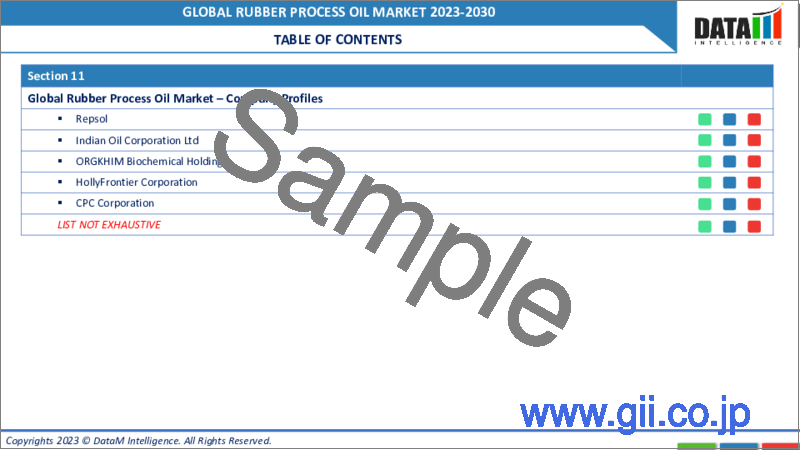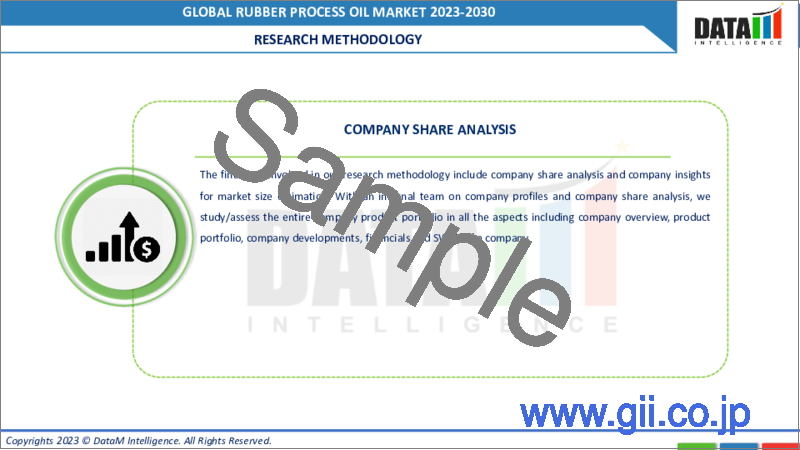|
|
市場調査レポート
商品コード
1179868
ゴム加工油の世界市場-2023-2030Global Rubber Process Oil Market - 2023-2030 |
||||||
|
● お客様のご希望に応じて、既存データの加工や未掲載情報(例:国別セグメント)の追加などの対応が可能です。 詳細はお問い合わせください。 |
|||||||
| ゴム加工油の世界市場-2023-2030 |
|
出版日: 2023年01月05日
発行: DataM Intelligence
ページ情報: 英文 235 Pages
納期: 約2営業日
|
- 全表示
- 概要
- 目次
市場概要
ゴム加工油の世界市場は、予測期間中(2023~2030年)に著しく成長すると予測されます。
ゴム加工油は、ゴム産業の製品別です。ゴム、燃料油、他産業の原料のすべてがここから得られます。様々なゴム化合物を作る際の増粘剤、軟化剤として使用されます。医薬品や化粧品では、キャリアオイルとして使用されます。RPOには合成品と非合成品がある(天然ゴム加工油とも呼ばれる)。プロセスオイルは、パラフィンやナフサなど分子量分布の異なる芳香族化合物のブレンドで、ゴム製品の製造時に加工助剤として使用されます。ゴム加工油は、エクステンダーや可塑剤として機能し、フィルターを組み込むプロセスの能力を向上させる。潤滑油画分は、芳香族に選択的に親和性のある溶剤で抽出され、ゴム加工油となります。ナフテン系オイルは、熱安定性、色安定性、溶解性などに優れています。このため、LPGチューブやスリッパ、フロアタイルなどの成形に適しています。エチレンプロピレンゴムには、パラフィン系オイルが多用されています。粘度に対する安定性が最も高く、引火点も最も高いです。市場は種類(ナフテン系、パラフィン系、芳香族系)と用途(ゴム加工、潤滑、接着剤・シーラント、医薬品、その他)に分類されます。
市場力学
ゴム加工油の世界市場は、自動車用低粘度油の需要増により、大きく伸びると予想されます。また、急速に成長するタイヤ産業や自動車需要の増加も、市場の成長を後押しするものと思われます。さらに、ゴム加工油の製造工程における技術開発の増加、環境に優しいゴム加工油の世界の需要の増加、研究開発活動の活発化により、ゴム加工油市場のメーカーに新たな成長の見通しがもたらされるでしょう。色、熱安定性、より良い溶解性のために、ナフテン系オイルは、湯たんぽ、LPGチューブ、履物、成形品や押出品の製造に有利です。
ゴム加工油は、ゴム化合物の最終製品のコストを削減するために加硫の物理的特性を向上させ、これは市場の成長を促進する主要な要因の一つです。また、ほとんどのエラストマーと相性が良いため、より幅広い用途で使用されています。
しかし、原油価格の変動や、タイヤの製造・生産における多環芳香族炭化水素の禁止に関する欧州連合指令による厳しい規制の実施は、予測期間中、ゴム加工油市場のメーカーに大きな課題を突きつける可能性があります。
バイオベースのゴム加工油の需要の高まりが、有利な将来の成長見通しを提供する
バイオベースオイルは、石油ベースの製品に代わってエラストマーの可塑剤として使用できる新しいタイプのオイルです。従来の石油系可塑剤と比較すると、安価で再生可能であり、多くの利点があります。バイオベースオイルは通常、いくつかの官能基を持ち、様々な用途に加工、変更、重合することができます。バイオベースオイルの使用方法は変化しており、このことはカーボンブラック充填SBRコンパウンドに使用される変性大豆油の例で説明できます。同様の機械的特性と性能予測は、従来のゴムとオイルのマトリックスを置き換えるためにバイオベースの材料を使用することを支持しています。
また、ゴムには、環境に優しく再生可能であることから、石油の代わりにバイオベースのオイルから作られた可塑剤を使用することができます。タイヤ、自動車部品、その他の工業用ゴム製品では、製造工程にさまざまなバイオベースのオイルが採用されています。そのため、バイオベースの加工油剤の需要が市場の成長を支えています。
潤滑油や自動車タイヤなどの用途でさまざまな機能を提供できるため、ゴム加工油の市場は世界的に拡大している
ゴム加工油(RPO)は、内部潤滑油として機能し、ゴム配合を強化し、充填材やその他の添加物の組み込みを容易にし、一部の物理的特性を高め、安価な増量剤として機能します。また、履物、シーリング材、床材、接着剤、タイヤなどの製造にも広く使用されています。その応用性の高さから、ゴム加工油の急成長が期待されています。
COVID-19の影響度分析
COVID-19の発生が深刻な影響を及ぼしている産業の1つに、ゴム産業があります。ゴムはタイヤ産業向けに作られたもの以外にも、数え切れないほどの製品に使用されています。履物、ベルトやホース、ラテックスフォームなど、タイヤ以外の製品がゴム需要の大半を占めています。ゴムはその耐衝撃性から、特に電子機器や消費財産業で最も求められている製品の一つです。輸送の制限、労働力不足、その他の政府による規制のため、ゴムのサプライチェーンは世界的に混乱状態にあります。サプライチェーンは、中国における工場や生産の閉鎖によって大きく混乱し、その結果、様々なゴム製品のコストが急激に上昇しています。
さらに、さまざまな産業で需要が減少しているため、メーカーは生産能力の削減を余儀なくされています。国際市場における原材料であるゴムの価格にも影響を及ぼしています。需要の減速と供給不足にもかかわらず、ゴムの価格は大きく変化していないです。したがって、COVID-19はゴム業界にそれなりの影響を与えたといえます。
目次
第1章 ゴム加工油の世界市場- 調査手法と調査範囲
- 調査手法
- 調査目的および調査範囲
第2章 ゴム加工油の世界市場-市場の定義と概要
第3章 ゴム加工油の世界市場-エグゼクティブサマリー
- タイプ別市場内訳
- 用途別市場内訳
- 地域別市場内訳
第4章 ゴム加工油の世界市場-市場力学
- 市場影響因子
- 促進要因
- 潤滑油や自動車タイヤなどの用途で様々な機能を提供できることから、ゴム加工油市場は世界的に拡大している
- 抑制要因
- 原油価格の変動と厳しい規制が市場成長の妨げとなります。
- 事業機会
- 影響分析
- 促進要因
第5章 ゴム加工油の世界市場- 産業分析
- ポーターのファイブフォース分析
- サプライチェーン分析
- 価格設定分析
- 規制分析
第6章 ゴム加工油の世界市場-COVID-19分析
- COVID-19の市場分析
- COVID-19以前の市場シナリオ
- COVID-19の現在の市場シナリオ
- COVID-19の後、または将来のシナリオ
- COVID-19の中での価格ダイナミクス
- 需要-供給スペクトラム
- パンデミック時の市場に関連する政府の取り組み
- メーカーの戦略的な取り組み
- まとめ
第7章 ゴム加工油の世界市場- タイプ別
- ナフテン系
- パラフィン系
- 芳香族系
- その他
第8章 ゴム加工油の世界市場(用途別
- ゴム加工
- 接着剤・シーラント
- 医薬品
- 消費者製品
- その他
第9章 ゴム加工油の世界市場-地域別
- 北米
- 米国
- カナダ
- メキシコ
- 欧州
- ドイツ
- 英国
- フランス
- イタリア
- ロシア
- その他欧州
- 南米
- ブラジル
- アルゼンチン
- その他の南米地域
- アジア太平洋地域
- 中国
- インド
- 日本
- オーストラリア
- その他アジア太平洋地域
- 中東とアフリカ
第10章 ゴム加工油の世界市場- 競争情勢
- 競合シナリオ
- 市況/シェア分析
- M&A(合併・買収)分析
第11章 ゴム加工油の世界市場-企業プロファイル
- Royal Dutch Shell
- 企業概要
- 製品ポートフォリオと説明
- 主なハイライト
- 財務概要
- Chevron Corporation
- Nynas
- Apar Industries Ltd
- Panama Petrochem Ltd
- Repsol
- Indian Oil Corporation Ltd
- ORGKHIM Biochemical Holding
- HollyFrontier Corporation
- CPC Corporation
第12章 ゴム加工油の世界市場-重要考察
第13章 ゴム加工油の世界市場-DataM
Market Overview
The global rubber process oil market reached US$ XX million in 2022 and is projected to record significant growth by reaching up to US$ XX million by 2030, growing at a CAGR of XX% during the forecast period (2023-2030).
Rubber process oil is a by-product of the rubber industry. Rubber, fuel oil and raw materials for other industries can all be obtained from it. It is a thickening and softening agent when creating different rubber compounds. In pharmaceuticals and cosmetics, it serves as a carrier oil. RPO is available in synthetic and non-synthetic varieties (also known as natural rubber process oil). Process oils are blends of paraffin, naphtha and other aromatic compounds with a range of molecular weight distributions that are used as a processing aid in the production of rubber goods. Rubber process oils serve as an extender or a plasticizer, enhancing the process's ability to incorporate filters. The lube oil fraction is extracted with a solvent that has a selective affinity for aromatics to create the rubber process oil. Naphthenic oils have exceptional thermal stability, color stability and solubility. These characteristics make them perfect for molding items such as LPG tubes, slippers and floor tiles. Ethylene propylene rubbers make extensive use of paraffinic oils. They are the most stable for a given viscosity and have the highest flashpoint. The market is segmented into type (naphthenic, paraffinic and aromatic) and application (rubber processing, lubrication, adhesive & sealants, pharmaceuticals and others).
Market Dynamics
The global market for rubber process oils is expected to be significantly boosted by the rising demand for low-viscosity oils for use in automobiles. In addition, the market growth will be assisted by the rapidly growing tire industry and rising automotive demand. Additionally, increasing technological developments in the rubber process oil production process, increasing global demand for green rubber process oils and increasing R&D activities will lead to the new growth prospect for the manufacturers in the rubber process oil market. Owing to the color, thermal stability and better solubility, naphthenic oils are more favorable for producing hot-water bags, LPG tubes, footwear and molded and extruded goods.
Rubber process oil improves the physical properties of vulcanization to reduce the cost of end products of rubber compounds which is one of the major factors driving the market growth. Moreover, compatibility with most of the elastomer types makes its usage broader.
However, the fluctuation of crude oil prices and the implementation of strict regulations by the European Union Directive regarding the prohibition of polycyclic aromatic hydrocarbons for the manufacturing and production of tires may pose a significant challenge to manufacturers in the rubber process oil market during the forecast period.
Rising demand for bio-based rubber processing oils will provide lucrative future growth prospects
Bio-based oil is a new type of oil that can be used as a plasticizer in elastomers in place of petroleum-based products. Compared to traditional petroleum plasticizers, it is cheap, renewable and has many benefits. Bio-based oil typically has several functional groups and can be processed, altered or polymerized for various applications. The use of bio-based oils has changed and this is illustrated by an example of modified soybean oil used in carbon black-filled SBR compounds. Similar mechanical properties and performance predictors support using bio-based materials to replace traditional rubber and oil matrices.
Rubbers can also employ plasticizers made from bio-based oil instead of petroleum because they are environmentally friendly and renewable. Tires, automotive components and other industrial rubber products have all adopted various bio-based oils into their manufacturing processes. Therefore, the demand for bio-based processing oils supports market growth.
The ability to offer a variety of functions in applications such as lubrication and automobile tires allows the rubber process oil market to gore globally
Rubber process oils (RPO) serve as internal lubricants, enhance rubber formulation blending, make it easier to incorporate fillers and other additives, enhance some physical properties and serve as inexpensive extenders. These oils are also widely used in producing footwear, sealants, flooring materials, adhesives and tires. Due to its applicability, rubber process oil is expected to grow quickly.
COVID-19 Impact Analysis
One of the industries that the COVID-19 outbreak has severely impacted is the rubber industry. Rubber is used in countless products besides those made for the tire industry. Non-tire products like footwear, belts and hoses, latex foam and many others account for the majority of the demand for rubber. Due to its shock resistance, rubber is one of the most sought-after products, particularly in the electronics and consumer goods industries. Due to transportation limitations, a labor shortage and other governmental restrictions, the supply chain for rubber has been disrupted globally. The supply chain has been severely disrupted by the closure of factories and production in China, which has caused a sharp rise in the cost of various rubber products.
Additionally, manufacturers have had to reduce their production capacities due to the decreased demand for goods across various industries. It has also impacted the cost of rubber as a raw material in the international market. The price of rubber has not changed significantly despite a slowdown in demand and a shortage of supply. Therefore, COVID-19 had a decent impact on the rubber industry.
Segment Analysis
The global rubber process oil market is segmented based on type, application and region.
To enhance the features of chemical compounds, rubber processing application is gaining attraction among all applications, bolstering the market growth
Rubber process oils are used when combining rubber compounds; they enhance the fillers' dispersion and the compound's flow properties during further processing. Rubber Process Oils are designed to meet various rubber products' specific viscosity and aniline point requirements. To create rubber goods like tires, rubber bands, hoses, toys and other rubber products, they are commercially used as a component in a mixture of rubber compounds. The demand for rubber process oil in rubber processing is likely to increase as more industrial and automotive products made with rubber are used in developing nations. As a result of the factors above, the rubber processing application segment is projected to dominate the global rubber process oil market during the forecast period.
Geographical Analysis
The global rubber process oil market is segmented based on type, application and region.
The rapid infrastructure developments across emerging nations in Asia-Pacific support the market's growth. However, the Asia-Pacific is projected to grow at the highest CAGR during the forecast period
India is the largest manufacturer of natural rubber and ranked third in terms of consumption of natural rubbers. India imports crude oil from countries like Iraq, Russia and Saudi Arabia and transforms it into a variety of petroleum products. Rubber processing oil is one of the by-products. India is the second largest exporter of petroleum-derived products in Asia. Consumption in this region is anticipated to increase due to the growing demand for rubber process oil from the rubber industry and its increasing use in the automotive industry in nations like China, Japan and India.
China has been both the largest consumer and importer of rubber in the world, consuming about 40% of the total production. With one of the highest levels of productivity, India is currently the sixth-largest rubber producer in the world. Additionally, the higher production of petroleum products in this region leads to the growth of the rubber industry, which in turn will boost market growth.
Competitive Landscape
Key rubber process oil players are focusing on the development of new technologies to enhance the quality of the production of petroleum products. The primary focus areas include product launches, collaborations, strategic mergers and acquisitions. The major players in the market are Royal Dutch Shell, Chevron Corporation, Nynas, Apar Industries Ltd, Panama Petrochem Ltd, Repsol, Indian Oil Corporation Ltd orGKHIM Biochemical Holding, HollyFrontier Corporation and CPC Corporation.
Royal Dutch Shell
Overview: Royal Dutch Shell is a group of petrochemical and energy companies with more than 82,000 employees. It serves more than 70 countries. The company uses innovative technologies and adopts a creative strategy to support the development of a sustainable energy future. The company operates in three segments: upstream, downstream, integrated gas & renewables, and energy solutions (formally known as new energies). The company serves the market of Europe, the Americas, MEA, Asia-Pacific and Africa. The company produces 3.2 equivalent barrels of oil per day.
Product Portfolio:
- Shell Ondina X: This product is a high-quality Next, generation process oil equipped with gas-to-liquids (GTL) technology. Because they are produced using hydrocarbons derived from natural gas rather than crude oil, Shell's GTL-based process oils have a consistent chemical structure. A new generation of white medical oils with a unique molecular structure is called Shell Ondina X. This enables them to have low viscosity while displaying a carbon chain distribution and evaporation loss properties similar to a higher viscosity traditional medicinal white oil. The product application includes adhesives, rubber, pharmaceuticals & cosmetics, defoamers and thermoplastic elastomers.
Key Development: On November 15, 2022, A subsidiary of Shell plc named Shell Chemical Appalachia LLC announced that Shell Polymers Monaca, a Pennsylvania Chemical project, has begun its operations. The Pennsylvania facility, which has a designed output of 1.6 million tonnes annually, is the first significant polyethylene manufacturing complex in the Northeastern U.S.
Why Purchase the Report?
- To visualize the global rubber process oil market segmentation based on type, application and region, as well as understand key commercial assets and players.
- Identify commercial opportunities in the global rubber process oil market by analyzing trends and co-development.
- Excel data sheet with numerous data points of rubber process oil market-level with two segments.
- PDF report consisting of cogently put together market analysis after exhaustive qualitative interviews and in-depth market study.
- Product mapping available as excel consisting of key products of all the major market players.
The global rubber process oil market report would provide approximately 53 tables, 50 figures and 235 pages.
Target Audience 2023
- Manufacturers/ Buyers
- Industry Investors/Investment Bankers
- Research Professionals
- Emerging Companies
Table of Contents
1. Global Rubber Process Oil Market - Methodology and Scope
- 1.1. Research Methodology
- 1.2. Research Objective and Scope of the Report
2. Global Rubber Process Oil Market - Market Definition and Overview
3. Global Rubber Process Oil Market - Executive Summary
- 3.1. Market Snippet by Type
- 3.2. Market Snippet by Application
- 3.3. Market Snippet by Region
4. Global Rubber Process Oil Market-Market Dynamics
- 4.1. Market Impacting Factors
- 4.1.1. Drivers
- 4.1.1.1. The ability to offer a variety of functions in applications such as lubrication and automobile tires allows the rubber process oil market to gore globally
- 4.1.1.2. XX
- 4.1.2. Restraints
- 4.1.2.1. Fluctuation of crude oil prices and the strict regulations hamper the market growth
- 4.1.2.2. XX
- 4.1.3. Opportunity
- 4.1.3.1. XX
- 4.1.4. Impact Analysis
- 4.1.1. Drivers
5. Global Rubber Process Oil Market - Industry Analysis
- 5.1. Porter's Five Forces Analysis
- 5.2. Supply Chain Analysis
- 5.3. Pricing Analysis
- 5.4. Regulatory Analysis
6. Global Rubber Process Oil Market - COVID-19 Analysis
- 6.1. Analysis of COVID-19 on the Market
- 6.1.1. Before COVID-19 Market Scenario
- 6.1.2. Present COVID-19 Market Scenario
- 6.1.3. After COVID-19 or Future Scenario
- 6.2. Pricing Dynamics Amid COVID-19
- 6.3. Demand-Supply Spectrum
- 6.4. Government Initiatives Related to the Market During Pandemic
- 6.5. Manufacturers Strategic Initiatives
- 6.6. Conclusion
7. Global Rubber Process Oil Market - By Type
- 7.1. Introduction
- 7.1.1. Market Size Analysis and Y-o-Y Growth Analysis (%), By Type
- 7.1.2. Market Attractiveness Index, By Type
- 7.2. Naphthenic*
- 7.2.1. Introduction
- 7.2.2. Market Size Analysis and Y-o-Y Growth Analysis (%)
- 7.3. Paraffinic
- 7.4. Aromatic
- 7.5. Others
8. Global Rubber Process Oil Market - By Application
- 8.1. Introduction
- 8.1.1. Market Size Analysis and Y-o-Y Growth Analysis (%), By Application
- 8.1.2. Market Attractiveness Index, By Application
- 8.2. Rubber Processing*
- 8.2.1. Introduction
- 8.2.2. Market Size Analysis and Y-o-Y Growth Analysis (%)
- 8.3. Adhesives & Sealants
- 8.4. Pharmaceuticals
- 8.5. Consumer Products
- 8.6. Others
9. Global Rubber Process Oil Market - By Region
- 9.1. Introduction
- 9.1.1. Market Size Analysis and Y-o-Y Growth Analysis (%), By Region
- 9.1.2. Market Attractiveness Index, By Region
- 9.2. North America
- 9.2.1. Introduction
- 9.2.2. Key Region-Specific Dynamics
- 9.2.3. Market Size Analysis and Y-o-Y Growth Analysis (%), By Type
- 9.2.4. Market Size Analysis and Y-o-Y Growth Analysis (%), By Application
- 9.2.5. Market Size Analysis and Y-o-Y Growth Analysis (%), By Country
- 9.2.5.1. U.S.
- 9.2.5.2. Canada
- 9.2.5.3. Mexico
- 9.3. Europe
- 9.3.1. Introduction
- 9.3.2. Key Region-Specific Dynamics
- 9.3.3. Market Size Analysis and Y-o-Y Growth Analysis (%), By Type
- 9.3.4. Market Size Analysis and Y-o-Y Growth Analysis (%), By Application
- 9.3.5. Market Size Analysis and Y-o-Y Growth Analysis (%), By Country
- 9.3.5.1. Germany
- 9.3.5.2. UK
- 9.3.5.3. France
- 9.3.5.4. Italy
- 9.3.5.5. Russia
- 9.3.5.6. Rest of Europe
- 9.4. South America
- 9.4.1. Introduction
- 9.4.2. Key Region-Specific Dynamics
- 9.4.3. Market Size Analysis and Y-o-Y Growth Analysis (%), By Type
- 9.4.4. Market Size Analysis and Y-o-Y Growth Analysis (%), By Application
- 9.4.5. Market Size Analysis and Y-o-Y Growth Analysis (%), By Country
- 9.4.5.1. Brazil
- 9.4.5.2. Argentina
- 9.4.5.3. Rest of South America
- 9.5. Asia-Pacific
- 9.5.1. Introduction
- 9.5.2. Key Region-Specific Dynamics
- 9.5.3. Market Size Analysis and Y-o-Y Growth Analysis (%), By Type
- 9.5.4. Market Size Analysis and Y-o-Y Growth Analysis (%) By Application
- 9.5.5. Market Size Analysis and Y-o-Y Growth Analysis (%), By Country
- 9.5.5.1. China
- 9.5.5.2. India
- 9.5.5.3. Japan
- 9.5.5.4. Australia
- 9.5.5.5. Rest of Asia-Pacific
- 9.6. Middle East and Africa
- 9.6.1. Introduction
- 9.6.2. Key Region-Specific Dynamics
- 9.6.3. Market Size Analysis and Y-o-Y Growth Analysis (%), By Type
- 9.6.4. Market Size Analysis and Y-o-Y Growth Analysis (%), By Application
10. Global Rubber Process Oil Market - Competitive Landscape
- 10.1. Competitive Scenario
- 10.2. Market Positioning/Share Analysis
- 10.3. Mergers and Acquisitions Analysis
11. Global Rubber Process Oil Market- Company Profiles
- 11.1. Royal Dutch Shell*
- 11.1.1. Company Overview
- 11.1.2. Product Portfolio and Description
- 11.1.3. Key Highlights
- 11.1.4. Financial Overview
- 11.2. Chevron Corporation
- 11.3. Nynas
- 11.4. Apar Industries Ltd
- 11.5. Panama Petrochem Ltd
- 11.6. Repsol
- 11.7. Indian Oil Corporation Ltd
- 11.8. ORGKHIM Biochemical Holding
- 11.9. HollyFrontier Corporation
- 11.10. CPC Corporation
LIST NOT EXHAUSTIVE
12. Global Rubber Process Oil Market- Premium Insights
13. Global Rubber Process Oil Market- DataM
- 13.1. Appendix
- 13.2. About Us and Services
- 13.3. Contact Us




